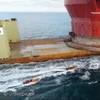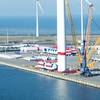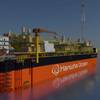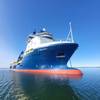GE Orders Two Crew Transfer Vessels for French Offshore Wind Farm
GE Renewable Energy Offshore Wind (GE) has ordered two crew transfer vessels destined to serve the Saint-Nazaire offshore wind farm in France.
GE has ordered the vessels from Louis Dreyfus Armateurs and Tidal Transit. The two crew transfer vessels will be designed by naval architect Mauric and built by French shipyard Ocea.
LD Tide, a joint venture between Louis Dreyfus Armateurs and Tidal Transit will operate the two CTVs for the transfer of maintenance technicians to the Saint-Nazaire wind farm.
"The two CTVs will sail under the French flag and will have the mission of ensuring the transfer of technicians (24 offshore wind technicians per crossing) between the coast and the farm for wind turbine maintenance," Louis Dreyfus Armateurs said.
The construction of the two CTVs will start in 2021 with commissioning scheduled for 2022.
The Saint Nazaire offshore wind project reached a positive final investment decision in 2019 and is expected to enter service in 2022.
Located in the Loire-Atlantique region in coastal France, the project is a 480-megawatt (MW) wind farm that will feature 80 GE Haliade 160-6MW turbines to be manufactured in France.
According to GE, each Haliade turbine powers 5,000 homes. The project is expected to generate the equivalent of 20% of the Loire-Atlantique’s electricity consumption.
Turbines will be located between 12 and 20 kilometers off the Loire-Atlantique coast, at depths ranging from 12 to 25 meters, and deployed an area of about 78 square km. The project is being developed by Eolien Maritime France (EMF).
Provisional technical characteristics of the two CTVs
• Length: 26.70 m
• Width: 9.40m
• Draught: 1.80 m
• 24 technicians
• 3 crew members
• Service speed: > 25 knots
• Cargo capacity: 10 tons
• Propulsion: IMO tier III, hybrid (batteries) & hydrogen ready Technical innovations / Environmental impact
• Semi-swath hull shape, allowing for better seakeeping performance to facilitate the transfer of technicians in rough seas (2 HS meters) and improve comfort in transit.
• Aluminium construction and addition of a T-Foil (load-bearing plane) to reduce fuel consumption.
• Connection to shore power during stopovers















